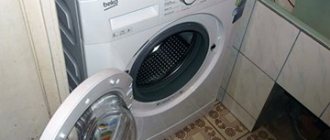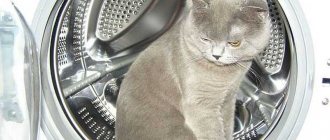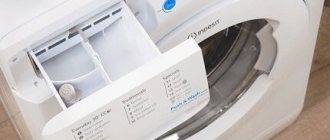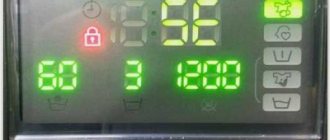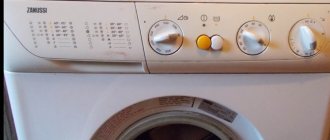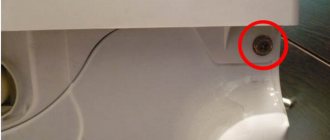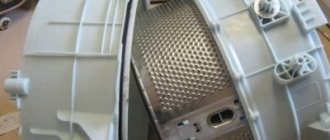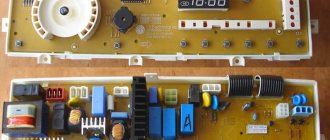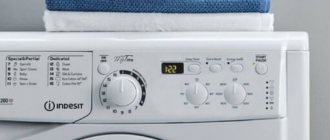In our country, washing machines from the South Korean company Samsung are very popular.
Accordingly, many users are interested in how to restore the functionality of such a device in the event of a simple breakdown.
Indeed, the owner will be able to fix some problems himself, without resorting to the help of a paid service.
Next, we will look at how to repair a Samsung washing machine with your own hands, what malfunctions occur most often and what needs to be done to ensure that the device works without such measures for as long as possible.
List of required tools
You can’t take a “Korean” with your bare hands - you need to prepare something:
- a set of screwdrivers or a screwdriver with a replaceable tip;
- a set of socket and open-end wrenches;
- adjustable pliers (the grip width can be adjusted);
- pliers;
- side cutters;
- two tweezers: one with increased length, the second with curved tips;
- soldering iron with a power of 30 - 40 W;
- knife;
- mirror with long handle;
- flashlight or small electric lamp;
- low power gas burner;
- crimping pliers for fixing wires in lugs and contact connectors;
- a flexible metal ruler with a length of 70 cm or more (using this tool, it is possible to rotate the drum into its normal position, the flaps of which were left open by mistake by the user when starting the machine);
- a magnet on a nylon thread or nylon cord (helps to remove small metal objects that have gotten inside the unit);
- hammer weighing from 300 to 400 g;
- pliers for dismantling spring clamps that secure flexible hoses to fittings.
You will also need the following measuring instruments:
- multimeter;
- voltage indicator in the form of a screwdriver;
- current clamps or ammeter for alternating current at 20 A (used to estimate the power consumed by the heating element during heating).
In addition to the indicated devices and tools, you may also need some materials:
- Super glue;
- silicone sealant;
- sealing/insulating compound;
- wire lugs;
- rosin for soldering or flux LTI-120;
- heat-shrinkable tubes of different diameters;
- stranded wire;
- metal and plastic clamps;
- fuses for current 4 - 5 A;
- insulating tape.
Prepare a liquid for treating rusted connections, for example, “Liquid Key”.
Often during repairs it is necessary to understand whether power is supplied to the heating element. To do this, just turn on the machine to warm up and look at the electric meter: the rotation speed of the disk or the blinking frequency of the LEDs (for electronic meters) should increase.
Drive belt
Over time, it “breaks apart” and tears. Overloading with laundry speeds up this process. Please note that the belt may stretch. In this case, it scrolls and washing will be impossible.
Replacement instructions:
- Remove the cover from the back, first unscrew the screws.
- Pull the belt towards you and at the same time rotate the pulley. We're filming.
- It's more difficult to install. First we put it on the motor shaft and hold it.
- With the other hand we place it on the pulley, twisting it at the same time.
Expert opinion
I work in the household appliance repair industry. Extensive experience in restoring washing machines and dishwashers.
Ask a Question
Important! Select the belt exactly the same!
Belt pulley
The process of disassembling the washing machine
It is not always necessary to completely disassemble the car, but when repairing some components, this cannot be avoided. “Arrange a showdown” should be in this order:
- The top cover is removed: this element is held in place by two screws on the back side of the unit. After unscrewing them, the lid must be moved back 1.5 cm, after which it can be removed. At this stage, the network (anti-interference) filter, level relay and transformer will become available.
- Next, you need to remove the distribution hopper for washing powder and disconnect the three hoses held by metal clamps from it. The clamps should be loosened using special pliers or pliers.
- The massive counterweight found under the top cover is removed from the bottom up after unscrewing two long bolts.
- We remove the front panel: to do this, you need to unscrew the screws that secure the control panel (two in front and one on the right). The left side of the front panel can then be detached using a screwdriver. Next, pull out the lever and disconnect the base panel (this item does not apply to the R 6091 model). Now you need to remove the hatch seal by releasing the clamp holding it.
After this, the front panel can be removed by first unscrewing the 8 screws that secure it.
At this stage, the heating element, hatch lock, shock absorbers and drain pump become available.
Disassembling the washing machine
Your next steps:
- On the wire clamp that presses the rubber casing to the drum (through this part the drum is connected to the body), you need to unscrew the bolt.
- With the car on its side, you need to unscrew the 4 screws on the bottom cover, after which it can be removed. This will give you access to the electric motor and another, smaller counterweight. These elements, together with the pump, are fixed on shock absorbers, which, in turn, are attached to the body of the machine.
- We disconnect the wires connected to them from the contact connectors of the engine and pump. In order not to forget the connection order, the wires must be photographed or marked in some way before disconnecting.
- We unscrew the two bolts that secure the shock absorbers to the body.
- Unscrew the water inlet located under the top cover. There is no need to disconnect the wires from it, since they do not interfere with the disassembly process.
- To dismantle the elastic suspensions with which the drum is connected from above to the body, the hooks at their ends must be straightened with pliers - first from the drum side, then from the body side. Be prepared for the fact that they do not give in very willingly.
- All that remains is to unscrew the smaller counterweight and remove the drive belt, after which the drum can be removed.
When assembling, the belt should be placed first on the engine pulley and only then on the drum pulley.
Hatch handle
Trivial breakdown. This is caused by improper use. Most inexpensive models are equipped with thermal plate locks. It is she who blocks the hook and prevents the hatch from opening during the washing period.
But after the end of the cycle, the plate needs time to cool down - 2-3 minutes. If you read the instructions carefully, it is written there. But people usually don’t wait and pull the handle. Since it is plastic, it breaks over time.
Handle in a disassembled hatch
Actions:
- remove the hatch;
- unscrew the screws in a circle;
- divide into halves;
- changing the hatch handle.
Important! Different repair kits for different models! We select by serial number!
Are you using citric acid?
Oh yes! No
DIY washing machine repair
Let's look at typical situations that owners of Samsung washing machines have to face:
Washing machine won't turn on
If the unit does not respond when you press the power button, remove the plug from the outlet and reinsert it.
If this does not help, try plugging into this outlet some device that you are absolutely sure is working - this will help check the presence of voltage in it. If the check shows that everything is in order with the power supply, you need to call a specialist.
Water flows slowly into the machine
If water is slowly filling into the machine, you must first open the cold water tap on any of the mixers and make sure that there is sufficient pressure in the water supply. If the pressure is normal, you need to see if the water supply valve to the machine is fully open.
Next, the valve, filling hose and mechanical cleaning filter at the entrance to the machine are checked for the presence of debris and small objects.
Sometimes the reason for the slow filling of the washing machine lies in the low location of the drain hose - in this case, water will immediately pour out of it.
If your machine has a drain hose connected from below, its free end should be raised 2/3 of the height of the machine. With a lower position, the water will drain simultaneously with filling.
Stopping the washing machine during a cycle
The most common reason is that the machine is overloaded with laundry. After removing some of the things, the unit will return to normal operation.
Also, unplanned stops can occur due to poor contact in the power button, which results in periodic loss of power to the machine.
If the drum stops with a knock during the spin cycle, it means the machine was installed skewed (checked with a building level) or laundry got tangled in it.
The drum does not rotate
Most often, the reason is that the door is not closed tightly or the water supply to the machine has been stopped. If everything is in order with this, then the problem is in the electronic “brains” of the device and you cannot do without a specialist.
Water doesn't heat up
Typically, this phenomenon indicates failure of the heating element due to natural wear or due to the formation of a large amount of scale. In Samsung machines, the heater is located under the tank on the front panel side (it will need to be removed).
Before you start replacing the heating element, you need to check with a tester the presence of voltage at its contacts.
It happens that there is no heating due to a broken contact somewhere. Then you have to “ring” the entire electrical circuit. But more often the tester shows the presence of voltage, which indicates a malfunction of the heating element itself.
Having disconnected the wires and temperature sensor from the heater, you need to unscrew the nut holding it, after which the heating element can be removed.
If necessary, the seat needs to be cleaned, then a new heating element is installed. By connecting a temperature sensor and wires to it, you can assemble the unit.
Water does not drain/leaks/flows
If water begins to seep out through the powder container, it means that it is either full or the detergent has been left in it for too long, which has led to a blockage. The container must be removed, rinsed thoroughly and reloaded with the amount of powder specified in the instructions.
The reason for the appearance of a puddle of water on the floor is most often a disconnection or damage to one of the hoses - the fill or drain.
Drain hose
If their condition is satisfactory, you need to take a closer look at the door - perhaps water is leaking out due to a worn seal. There are also seals at the connection point of the filling hose. If there is a high degree of wear, they need to be replaced.
The machine's inability to discharge waste water is most often caused by foreign objects or debris getting into the drain pump, its filter, or the drain hose.
Repairing washing machines is expensive. Even for basic filter cleaning you will have to pay 600 rubles. Doing your own repairs can save you a lot of money. Ardo washing machine: do-it-yourself repair according to the master’s guide.
An overview of the main breakdowns of Bosch washing machines and methods for eliminating them are presented here.
Zanussi washing machines, despite their reliability, have weaknesses - a poor door lock design and a relatively weak drive belt. In this topic https://aquacomm.ru/cancliz/mnogokvartirnyie-doma/santehnika/zanussi-stiralnaya-mashina-remont-svoimi-rukami.html we will learn how to troubleshoot some problems ourselves.
Excessive noise in the washing machine/vibration
The unit may be too noisy if installed incorrectly or if the transport bolts behind the drum have not been removed. Another reason is that a foreign object, such as a button or coin, has gotten inside.
Also, strong noise may be a sign of destruction of one of the bearings. Replacing bearings is a rather complicated operation, since they are installed on the axle shafts and in mounting holes with interference; removal requires a special puller.
If unusual noise is heard while draining water, you need to check that the machine is installed correctly (level) and inspect the drain pump filter for the presence of foreign objects.
Bearing replacement
If a strange noise in the form of a roar, knocking or squeaking clearly comes from the electric motor, you need to contact a service center.
If the machine fills with water making a loud noise, it may be due to excessively high/low pressure or a foreign object getting into the fill hose. First of all, you need to try to normalize the pressure by turning the valve handwheel back and forth on the outlet for supplying water to the machine. If this does not affect the noise, you need to disconnect the hose and check it for debris or small objects inside. You also need to check the coarse (mechanical) filter at the entrance to the unit and clean it if necessary.
The door does not open
In Samsung machines, the door is locked until the wash is completed. Also, the hatch lock is blocked if there is a high temperature inside the unit (drying or heating mode).
In this case, you just need to wait a while until the inside of the car cools down somewhat.
If after this the door remains locked, find the small cover on the bottom right of the front panel and remove it. Underneath you will find a cable that must be pulled to open the door in an emergency. After this you will have to contact customer service.
heating element
Hard water causes the heater to break down, resulting in scale formation. On the heating element, due to constant heating, it turns into stone and damages the surface. Note that in regions where there is soft water, for example, in St. Petersburg and the surrounding area, heaters practically do not fail. Moscow has hard water, and such damage is a pressing issue.
Removing the heating element
In order to extend the service life, use anti-scale products: Calgon, professional converters, or folk ones in the form of citric acid.
The malfunction manifests itself in two ways:
- The heating element burns out;
- leakage occurs on the housing.
In both cases, diagnosis is carried out with a multimeter. In order to gain access to the contacts, you must remove the front panel. See the disassembly sequence here. Unhook the wires. We put the tester to check the resistance.
First, we examine the contacts that receive voltage. If there is infinity between them, then replacement is necessary. Then we set the maximum limit.
Expert opinion
I work in the household appliance repair industry. Extensive experience in restoring washing machines and dishwashers.
Ask a Question
Important! Reliable results can be obtained if the multimeter measures up to 40 MΩ.
We look at the resistance between ground and each contact. If the value is different from zero, then the heater must be replaced. Operation with current leakage will lead to incorrect operation and damage to the control module.
Other problems and their solutions
The following troubles also happen:
- The paint on the body has become stained, changed color, or started to peel. Rust has appeared on metal parts: similar phenomena occur if the machine is installed in a room with high humidity. It is necessary to either move it to another location or install a dehumidifier in the room.
- The display does not light up or does not work at all, or the image on it has stopped changing.
The cause of the latter phenomenon may be increased humidity or water getting inside. The front panel should be dried and the car should be left overnight in a dry place. If drying does not help, you will have to call a professional.
The types of breakdowns of all washing machines are similar. In the next article we will talk about Kandy brand devices. Kandy washing machine - do-it-yourself repair of basic faults.
See this link for common breakdowns of Indesit washing machines and how to fix them.
Pump
The drain pump must be in use for 8 years or more. Constant blockages lead to malfunction. They occur in the following elements:
- drain hose;
- pipe branch;
- pump.
The pump itself and the filter must be periodically washed and foreign objects removed. To carry out this procedure, open the small hatch on the lower right and unscrew the lid. There is a filter under the cover. We take it out and rinse with running water. We look inside and make sure that nothing is wound around the impellers. Otherwise we delete it.
Snail with drain pump
Important! There is always a small amount of water in the pump, so apply a cloth before cleaning!
With a clogged pipe or drain hose, everything becomes more complicated. To eliminate it, dismantling is necessary. There are two options:
- remove the front panel;
- turn the car on its side.
Both cases have their pros and cons.
Expert opinion
I work in the household appliance repair industry. Extensive experience in restoring washing machines and dishwashers.
Ask a Question
Important! If you turn it over, be sure to cover the electric motor with plastic wrap!
Control module
This part of the washing machine can be called, without exaggeration, the “brain” of the device. It controls all processes, when the unit begins to wash, it gives commands to all components, including the electric motor, to start or complete work. The control module has special programs installed that it executes. The list of these programs is different for each SMA model. There are more “smart” modules, with a large list of modes and tasks. There are simpler ones that give commands to perform the basic functions of washing and spinning.
When the electronics fail, the SMA begins to work with errors or stops altogether.
To control the washing process, the module requires information from different parts of the machine. For this, sensors are used that send signals to the “brain” of the washer:
- water level control sensor (pressure switch);
- thermostat;
- tachometer;
- other electronics.
Water level sensor
This sensor monitors the water level in the tank. With its help, the module learns information about its quantity when filling. An air chamber works in tandem with this sensor, which, depending on how full the tank is, supplies pressure to it.
Thermal sensor
There are two types of such devices in washing machines - thermostat and thermistor. The first can be seen on equipment from previous years. Thermostats, in turn, are divided into gas-filled and bimetallic. The latter use a relay: when the temperature changes, it closes. Gas-filled devices are filled with freon, which, when heated, closes the regulator contact.
Thermistor for washing machine
Sensors operating on thermistors are used in more advanced modern technology, calculating the resistance at the moment of heating. They are much more reliable and efficient than conventional thermostats. In addition, they take up noticeably less usable space.
Tachometer
A tachometer is used to control the engine rotation speed. Only with its help are different engine speed modes possible during the washing or spinning process.
Other electronics
This includes a variety of relays (for example, a hatch closing sensor), indicator lights and a display showing information about the current operation, and a navigation panel. So, in ATLANT car models, there are five types of panels:
- with LED indication;
- with segment display and light indication;
- control panel with LCD display;
- control panel with LCD display and navigation buttons;
- with LED indication and segment display.
Blockage in the drain tract
The drain becomes clogged with lint from clothes, pet hairs, coins and other small debris. Therefore, the Samsung washing machine does not drain water. A blockage that prevents water from draining can form in the drain pipe, filter, pump, drain hose or sewer.
| Signs | How to fix | Cost* (work only) |
| The machine does not drain the water or takes too long to drain. The breakdown may be accompanied by errors 5E (SE), E2, 5C or SUd, 5d (Sd). | The technician examines the drainage path, finds the blockage and removes it. | from 1300 rub. |
*The price is only for the work of the master, spare parts are paid separately.
How does a Samsung automatic machine work?
Samsung's latest technologies, which are used in the production of automatic washing machines (AWA), make them complex mechanisms. However, upon closer examination, the design of the unit is not difficult to understand.
The body of any model consists of:
- front panel,
- back wall,
- bottom and lid.
The external and internal parts of the unit are located according to the following diagram:
- On the front side there is a control panel, a powder tray, a drain pump, a hose, and a filter.
- On the top panel there is an inlet valve, a level switch, tank suspensions in the form of springs, and counterweights.
- On the front side there is a tank and shock absorbers.
- On the back surface there is a drive belt, motor, pulley, power cord, drain hose.
The internal filling of a technical product includes basic and additional devices. The main ones are:
- control module;
- electric motor;
- tank;
- heating element;
- electric pump
Control module
This unit in the washing appliance is the main electronic part. The control module is a kind of “brain” of the automatic machine ; it includes an indicator panel and the software module itself.
The power unit provides power and control of all functions performed. This is possible due to the connection of all sensors, electronics and actuators to the control module. If defects occur in the machine, a signal is sent to the electronic board and reflected on the panel in the form of blinking indicators or a code on the display.
The electronic board is very susceptible to voltage surges , so for flawless operation of the washing machine you need a device that protects it from voltage surges.
Motor and tachogenerator
These two important components in a washing machine function in pairs. The electric motor provides the drum rotation specified by the mode.
The commutator type motor is localized in the lower part of the MCA . It manipulates the drum through a special belt that is attached to the motor shaft and drum pulley. This design leads to periodic wear of the electric brushes and the need for more frequent repairs.
Article on the topic: Where can you sell your old washing machine in Ufa
The tachometer monitors the number of revolutions. The tachogenerator sends the result of its tracking to the control module, which checks the speed according to a given program.
Level sensor and filling valve
These details also work in synergy. The purpose of the pressure switch is to control the volume of water poured into the tank . Externally, this element is a round box with wires, fixed under the cover of the machine body.
The level sensor detects the pressure in the tank and sends information to the control module. The latter, upon receiving a sign of a sufficient amount of liquid, sends an order to the filling valve to stop drawing water.
The valve responsible for the flow of water from the water pipe has one, two or three coils . The voltage that is supplied to them after a corresponding signal from the control module causes the membrane in the inlet valve to open. When the voltage drops, the diaphragm valve closes and blocks the flow of water.
Tank and drum
The washing machine tank is a sealed plastic container that is filled with water. Inside it there is a metal drum into which the laundry is placed.
This part of the unit has special devices to improve the quality of washing:
- grooved protrusions;
- plastic rib punches;
- perforations in the walls.
The rotation of the drum is carried out due to a bearing built into the tank and a fixed shaft and transmission pulley.
Heating element and temperature sensor
The heating element (heating element) is located at the bottom of the machine under the tank . This part ensures that the water is heated during washing to a predetermined temperature. The heating element receives a command about the required temperature level from the control module, after which it starts working.
Heating is controlled by a temperature sensor (thermostat or thermistor), which is built into the housing of the heating element. Outwardly, it looks like a metal tube. When the required temperature level is reached, the temperature sensor sends a signal to the control unit, which in turn turns off the heating element.
Gas-filled thermostats are connected via a tube to the control panel temperature sensor. The contacts close as a result of the expansion of heated freon inside the tube.
The second type of temperature sensors - thermistors , work by measuring resistance while heating water. These devices are considered more advanced and reliable. They are used in the assembly of technologically advanced modern Samsung models.
Springs, shock absorbers and counterweights
These design elements are designed to neutralize vibration and “bouncing” of the washing unit during spinning. Vibration dampers consist of a piston and a tube. These parts are attached to the side wall of the housing and the bottom of the tank.
Springs hang from the top and keep the tank suspended . The service life of the bearing and belt depends on the quality and condition of the shock absorbers.
Counterweights (or weights in other words) are concrete or plastic stones located at the bottom of the rear panel of the machine. They keep the tank balanced. Despite their massiveness and integrity, these parts can also be damaged during operation.
The cause of failure is often a crack in the counterweights or loose bolts . In the latter case, the rattling of the device is eliminated by tightening the fasteners.
Article on the topic: What models of Bosch washing machines are produced in Germany
Locking device and cuff
The mechanism that holds the door closed is essentially an electronic lock. The hatch is first closed mechanically by clicking the lock. After activating the specified program, the door electronically locks, which is accompanied by a soft click.
The hatch locking device guarantees accidental opening of the door during operation of the SMA . Unlocking occurs after the completion of the program upon receipt of the corresponding command from the control module.
The cuff also plays a protective role against possible leaks through the gap between the hatch door and the tank. Externally, it looks like a rubber seal. This accessory part must always be in satisfactory condition: clean, dry, without cracks or other damage.
Pump, snail, filter
A pump is provided to pump dirty water out of the tank after washing or rinsing. There are two types of application in Samsung washing machines: synchronous and asynchronous.
There are two main elements in the design of any pump:
- Motor
- Impeller.
A so-called snail is attached to the top (or front) part of the pump. It is necessary to connect the drain hose.
The same part contains a filter that filters out debris. The pump blades, mounted perpendicularly to its axis, begin to move when the rotor starts.
When waste fluid is discharged, small objects remaining in clothing (paper clips, coins, buttons) may enter the pump, filter and hose. This leads to pump failure and the need for repair.
Hoses, pipes
These parts are designed to fill the tank with water and drain the waste liquid. The length of the hoses depends on the location of the machine and its distance from the sewer and water pipes. If it is necessary to reinstall the machine at a distant distance, use longer tubes.
The hoses are located outside the housing, while the pipes are located inside . The inlet and drain pipes work harmoniously and ensure unhindered flow of water.
New hoses and pipes are elastic and flexible. The appearance of cracks, deformations, and drying out threatens leaks, so failed main elements must be replaced in a timely manner.
Powder receiver
The dispenser is a container with different compartments for powder and conditioner . Detergents are loaded into the powder receptacle before starting the program and stored there until the desired washing phase begins.
After the soaking or washing mode is turned on, water enters the compartment with the powder and washes it into the tank. When the final rinse stage is initiated, water is poured through the conditioner compartment.
Call the master
Many users find it difficult to figure out Samsung devices and repairs on their own. To solve the problem, it is advisable to invite a specialist. He will conduct a full diagnostic of the device and identify the real cause of the problem.
Home repairs often result in the need for repeated intervention in the design of the washing machine. This is fraught with additional financial expenses.
You can find a responsible technician in service centers that service household appliances. Specialists have the ability to perform professional diagnostics using instruments.
The repair technology has been worked out in such workshops down to the smallest detail. Our craftsmen use proven products and high-quality components. The cost of repairing a Samsung if there is a problem with filling the tank depends on the cause of the breakdown.
The workshop price includes the following rates:
- replacement of the water supply valve – from 1100 rubles;
- flashing or replacing the control board – from 1,500 rubles;
- replacement of a water level sensor – from 1300 rubles;
- reinstallation of the door locking device – from 1500 rubles.
You can also find a person who does private repairs of washing machines at home. However, responding to such advertisements sometimes ends in new problems.
Private craftsmen do not provide a documented guarantee for their work and often inflate the price. A verbal agreement may not end in favor of the equipment owner. Therefore, contacting official workshops is more profitable from both a technical and economic point of view.
Forced drainage: why is it needed and how is it done?
In cases where the washing cycle has stopped and there is water inside, it is necessary to organize a forced drain. This needs to be done for several reasons:
- For further diagnostics and repairs, it is necessary that there is no water in the car.
- Leaving incompletely washed clothes in water for a long time can ruin things.
- It is not advisable to keep water in the car - it is not intended for long-term storage of liquid, and the called repairman will not come right away.
There are two relatively simple options for eliminating water:
- try to drain through the drain hose, completely lowering it to the floor, and redirecting the free end not into the sewer, but into a low bowl;
- through the emergency drain system, which is located on the front side below.
The video will show you how to force drain water:
